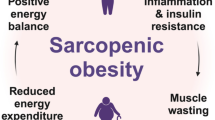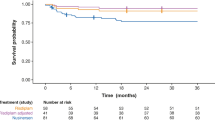Abstract
Background
Sarcopenia (SP) and intervertebral disc degeneration (IVDD) have a higher incidence in the elderly population. Previous studies have indicated a potential association between SP and IVDD. The objective of this study is to elucidate the potential causal relationship between sarcopenia-related traits and IVDD through Two-sample Mendelian randomization (MR) analysis.
Methods
We utilized a genome-wide association study conducted on the European population to collect aggregated data on sarcopenia and IVDD. Inverse variance weighting was primarily employed, supplemented by MR Egger, weighted median, simple model, and weighted model methods. Additionally, sensitivity analysis was performed to assess the robustness of the findings.
Results
Appendicular lean mass is positively associated with “Other intervertebral disc disorders” (OIDD) and “Prolapsed or slipped disc” (POSD) (OIDD: p = 0.002, OR = 1.120; POSD: p < 0.001, OR = 1.003), while grip strength (GS) is positively associated with POSD (left: p = 0.004, OR = 1.008; right: p < 0.001, OR = 1.010). It is worth mentioning that walking pace has significant causal relationship with “Low back pain” (LBP), “Lower back pain or/and sciatica” (LBPOAS), “Sciatica with lumbago” (SWL) and OIDD (LBP: p < 0.001, OR = 0.204; LBPOAS: p < 0.001, OR = 0.278; SWL: p = 0.003, OR = 0.249; OIDD: p < 0.001, OR = 0.256).
Conclusion
The present study revealed the causal relationship between SP-related traits and IVDD and recommended to prevent and treat sarcopenia as a means of preventing IVDD in clinic practice.


Similar content being viewed by others
Abbreviations
- MR:
-
Mendelian randomization analysis
- IVs:
-
Instrumental variables
- SP:
-
Sarcopenia
- IVDD:
-
Intervertebral disc degeneration
- EWGSOP:
-
European working group on sarcopenia in older people
- AWGS:
-
Asian working group for Sarcopenia
- SNPs:
-
Single nucleotide polymorphisms
- GWAS:
-
Genome-wide association study
- ALM:
-
Appendicular lean mass
- GS:
-
Grip strength
- WP:
-
Usual walking pace
- OIDD:
-
Other intervertebral disc disorders
- SWL:
-
Sciatica with lumbago
- LBPOAS:
-
Lower back pain or/and sciatica
- LBP:
-
Low back pain
- POSD:
-
Prolapsed or slipped disc
References
Cruz-Jentoft AJ, Sayer AA (2019) Sarcopenia. Lancet (London, England) 393(10191):2636–2646
Patel HP et al (2013) Prevalence of sarcopenia in community-dwelling older people in the UK using the European working group on sarcopenia in older people (EWGSOP) definition: findings from the Hertfordshire cohort Study (HCS). Age Ageing 42(3):378–384
Beard JR et al (2016) The World report on ageing and health: a policy framework for healthy ageing. Lancet (London, England) 387(10033):2145–2154
Janssen I et al (2004) The healthcare costs of sarcopenia in the United States. J Am Geriatr Soc 52(1):80–85
Cruz-Jentoft AJ et al (2019) Sarcopenia: revised European consensus on definition and diagnosis. Age Ageing 48(1):16–31
Kaplan SJ et al (2020) Thresholds and mortality associations of paraspinous muscle sarcopenia in older trauma patients. JAMA Surg 155(7):662–664
Damluji AA et al (2023) Sarcopenia and cardiovascular diseases. Circulation 147(20):1534–1553
Liu C et al (2022) Osteoporosis and sarcopenia-related traits: a bi-directional mendelian randomization study. Front Endocrinol 13:975647
Jones SE et al (2015) Sarcopenia in COPD: prevalence, clinical correlates and response to pulmonary rehabilitation. Thorax 70(3):213–218
Chen LK et al (2014) Sarcopenia in Asia: consensus report of the Asian working group for sarcopenia. J Am Med Dir Assoc 15(2):95–101
Cruz-Jentoft AJ et al (2010) Sarcopenia: European consensus on definition and diagnosis: report of the european working group on sarcopenia in older people. Age Ageing 39(4):412–423
Yang S et al (2020) Intervertebral disc ageing and degeneration: the antiapoptotic effect of oestrogen. Ageing Res Rev 57:100978
Kherad M et al (2017) Risk factors for low back pain and sciatica in elderly men-the MrOS Sweden study. Age Ageing 46(1):64–71
James SL, Abate D, Abate KH, Abay SM, Abbafati C, Abbasi N, Abbastabar H, Abd-Allah F, Abdela J, Abdelalim A, Abdollahpour I (2018) Global, regional, and national incidence, prevalence, and years lived with disability for 354 diseases and injuries for 195 countries and territories, 1990–2017: a systematic analysis for the global burden of disease study 2017. Lancet (London, England) 392(10159):1789–1858
Moradi K et al (2024) Erosive hand osteoarthritis and sarcopenia: data from Osteoarthritis Initiative cohort. Ann Rheum Dis. https://doi.org/10.1136/ard-2023-224997
Misra D et al (2019) Risk of knee osteoarthritis with obesity, sarcopenic obesity, and sarcopenia. Arthritis Rheumatol (Hoboken, N.J.) 71(2):232–237
Kim WJ et al (2021) Sarcopenia and back muscle degeneration as risk factors for degenerative adult spinal deformity with sagittal imbalance and degenerative spinal disease: a comparative study. World Neurosurg 148:e547–e555
Tanaka Y et al (2023) Muscle strength rather than appendicular skeletal muscle mass might affect spinal sagittal alignment, low back pain, and health-related quality of life. Sci Rep 13(1):9894
Skrivankova VW et al (2021) Strengthening the reporting of observational studies in epidemiology using mendelian randomization: the STROBE-MR statement. JAMA 326(16):1614–1621
Davies NM, Holmes MV, Davey Smith G (2018) Reading mendelian randomisation studies: a guide, glossary, and checklist for clinicians. BMJ (Clinical Research ed.) 362:k601
Smith GD, Ebrahim S (2003) Mendelian randomization: can genetic epidemiology contribute to understanding environmental determinants of disease? Int J Epidemiol 32(1):22
Skrivankova VW et al (2021) Strengthening the reporting of observational studies in epidemiology using mendelian randomisation (STROBE-MR): explanation and elaboration. BMJ (Clinical Research ed) 375:n2233
Pei Y-F et al (2020) The genetic architecture of appendicular lean mass characterized by association analysis in the UK biobank study. Commun Biol 3(1):608
Verbanck M et al (2018) Detection of widespread horizontal pleiotropy in causal relationships inferred from mendelian randomization between complex traits and diseases. Nat Genet 50(5):693–698
Ong J-S, MacGregor S (2019) Implementing MR-PRESSO and GCTA-GSMR for pleiotropy assessment in mendelian randomization studies from a practitioner’s perspective. Genet Epidemiol 43(6):609–616
Long Y et al (2023) Causal relationship between gut microbiota and cancers: a two-sample mendelian randomisation study. BMC Med 21(1):66
Sakai Y et al (2017) Sarcopenia in elderly patients with chronic low back pain. Osteoporos Sarcopenia 3(4):195–200
Sions JM et al (2017) Trunk muscle characteristics of the multifidi, erector spinae, psoas, and quadratus lumborum in older adults with and without chronic low back pain. J Orthop Sports Phys Ther 47(3):173–179
Suo M et al (2023) The association between morphological characteristics of paraspinal muscle and spinal disorders. Ann Med 55(2):2258922
Park MW, Park SJ, Chung SG (2023) relationships between skeletal muscle mass, lumbar lordosis, and chronic low back pain in the elderly. Neurospine 20(3):959–968
Quint U et al (1998) Importance of the intersegmental trunk muscles for the stability of the lumbar spine. biomech Study Vitro Spine 23(18):1937–1945
Kang S et al (2021) The effects of paraspinal muscle volume on physiological load on the lumbar vertebral column: a finite-element study. Spine 46(19):E1015–E1021
Hori Y et al (2021) Gender-specific analysis for the association between trunk muscle mass and spinal pathologies. Sci Rep 11(1):7816
Choi TY et al (2022) Psoas muscle measurement as a predictor of recurrent lumbar disc herniation: a retrospective blind study. Medicine 101(26):e29778
Studenski SA et al (2014) The FNIH sarcopenia project: rationale, study description, conference recommendations, and final estimates. J Gerontol Ser A Biol Sci Med Sci 69(5):547–558
Long G et al (2021) Hand grip strength as a predictor of recovery from low back pain in the pregnant women-a prospective study. J Orthop Sci Off J Jpn Orthop Assoc 26(4):566–571
Faber A et al (2012) Does muscle strength predict future musculoskeletal disorders and sickness absence? Occup Med (Oxford, England) 62(1):41–46
Felício DC et al (2017) Handgrip strength is associated with, but poorly predicts, disability in older women with acute low back pain: a 12-month follow-up study. Maturitas 104:19–23
Hansen L et al (2006) Anatomy and biomechanics of the back muscles in the lumbar spine with reference to biomechanical modeling. Spine 31(17):1888–1899
Distefano G, Goodpaster BH (2018) Effects of exercise and aging on skeletal muscle. Cold Spring Harbor Perspect Med 8(3):a029785
Beaudart C et al (2019) Assessment of muscle function and physical performance in daily clinical practice : a position paper endorsed by the European society for clinical and economic aspects of osteoporosis, osteoarthritis and musculoskeletal diseases (ESCEO). Calcif Tissue Int. https://doi.org/10.1007/s00223-019-00545-w
Cesari M et al (2009) Added value of physical performance measures in predicting adverse health-related events: results from the health, aging and body composition study. J Am Geriatr Soc 57(2):251–259
Funding
This research was supported by grant from the The Medical and Health Science and Technology Program of Hangzhou, China (No: A20220665).
Author information
Authors and Affiliations
Contributions
WQ, ZM, XM, YW, LZ, YS, GG, WZ, DW and HP contributed to this study. WQ, HP and ZM contributed to the conception and design of this study. WQ, YS and XM collected data. WQ, DW and LZ performed the statistical analysis. WQ, GG, and DW wrote the manuscript. HP and YW supervised the entire study. All authors contributed to the article and approved the submitted version. WQ, ZM and XM contributed equally to this work and share first authorship.
Corresponding authors
Ethics declarations
Conflict of interest
None of the authors has any potential conflict of interest.
Additional information
Publisher's Note
Springer Nature remains neutral with regard to jurisdictional claims in published maps and institutional affiliations.
Supplementary Information
Below is the link to the electronic supplementary material.
Rights and permissions
Springer Nature or its licensor (e.g. a society or other partner) holds exclusive rights to this article under a publishing agreement with the author(s) or other rightsholder(s); author self-archiving of the accepted manuscript version of this article is solely governed by the terms of such publishing agreement and applicable law.
About this article
Cite this article
Qi, W., Mei, Z., Mao, X. et al. Causal associations between sarcopenia-related traits and intervertebral disc degeneration: a two-sample mendelian randomization analysis. Eur Spine J (2024). https://doi.org/10.1007/s00586-024-08291-w
Received:
Revised:
Accepted:
Published:
DOI: https://doi.org/10.1007/s00586-024-08291-w




